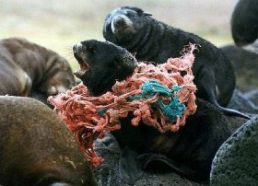Plastic meals for seals
Pieces of discarded plastic can end up in the stomachs of seals.
By Emily Sohn
 |
|
Discarded netting is not the only hazard that seals face. Bite-size pieces of plastic from ocean-battered containers such as milk jugs can end up in seal stomachs.
|
| Rolf Ream, National Marine Mammal Laboratory, National Oceanic and Atmospheric Administration |
For years, scientists have been worried about the effects of various types of plastic garbage. Seals, for example, often get entangled in plastic netting. Now there’s evidence that seals also end up swallowing plastic.
Between 1990 and 1997, Harry Burton and Cecilia Eriksson collected droppings from two species of Antarctic fur seals that live along beaches on Macquarie Island in Australia. The two researchers found 164 plastic chunks in the 145 pieces of scat they examined.
The irregular shapes and ripped edges of the plastic pieces suggested that they were once parts of larger objects, such as plastic containers.
The seals probably didn’t eat the plastic directly. Instead, they ate fish that had eaten the plastic after it had been broken to pieces by rocks and waves. The study shows just how far a little garbage can go.—E. Sohn
Going Deeper:
Harder, Ben. 2003. Seals’ meals, plastic pieces and all. Science News 164(Nov. 9):301. Available at http://www.sciencenews.org/20031108/note11.asp .
You can learn more about the effect of discarded plastics on seals at zoo.latrobe.edu.au/sdg/SMEGseal_fisheries.htm (La Trobe University) and www.pbs.org/odyssey/odyssey/20020206_log_transcript.html (PBS).







